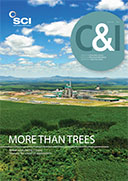Australian researchers have overcome a critical hurdle in boosting plant performance by manipulating gene networks. They ‘trick’ plants into thinking phosphate is scarce, which leads them to use this essential nutrient up to 50% more efficiently. If translated to crop plants, the findings could save farmers money and reduce run-off phosphorus in waterways by 20%, they claim.
Phosphate is a limited and non-renewable resource, with high-grade phosphate reserves gradually being exhausted. In the field, plants take up only a small percentage of applied phosphate fertiliser, with the rest remaining in the soil or lost as fertiliser run-off and ending up in waterways. So increasing phosphate uptake should mean less fertiliser wastage and, ultimately, a lower demand for fertiliser.
The team of researchers at the ARC Centre for Excellence in Plant Energy Biology at the University of Western Australia and the Centre for AgriBioscience at La Trobe University targeted the genes that regulate phosphate transport in plant roots. ‘By manipulating local gene networks, plants can be ‘tricked’ into thinking phosphate is scarce which puts them into a heightened state of alert, says senior researcher Ricarda Jost: ‘As a result, they will launch a number of responses that lead to higher phosphate uptake by roots.’
The researchers focused on genes in the cells of plant roots known to control nutrient flux. They were ‘delighted’ that plants with reduced expression of these genes grew much better than controls when exposed to lower phosphate levels (Plant Physiology; DOI: https://doi.org/10.1104/pp.16.01698). The mutants developed higher root and shoot biomass compared with the wildtype under low phosphate conditions. They took up more phosphate, but were also better equipped to metabolically convert this phosphate to promote growth.
‘Crops that lacked these negative regulators would require fewer fertiliser applications due to more efficient nutrient acquisition, reducing fertiliser run-off and water pollution,’ comments team leader Jim Whelan. ‘A win-win for farmers’ budgets and the environment.’
Sigrid Heuer, Principle Scientist at Rothamsted Research Plant Biology and Crop Science department, likes this approach of combining existing, previously unrelated, datasets to pull out novel genes. ‘Under their experimental conditions, plants produced more biomass with less phosphate. This is indeed a useful trait for breeding since it would require genuinely less phosphate.’ However, Arabidopsis seedlings are not necessarily a good model for crops, and growth in liquid culture medium doesn’t represent soil conditions, so it will be necessary to identify the corresponding genes from rice or other crops for evaluation and testing, she adds.





